The Geometric Period in Greek art is distinguished by a reliance on geometric shapes to create human and animal figures as well as abstract décor.
In the eleventh century BCE, the citadel centers of the Mycenaeans were abandoned and Greece fell into a period with little cultural or social progression. Signs of civilization including literacy, writing, and trade were lost and the population on mainland Greece plummeted.
During the Proto-Geometric Period (1050–900 BCE), painting on ceramics began to re-emerge. These vessels were decorated with abstract geometric shapes adopted from Mycenaean pottery. Ceramicists began using the fast wheel to create vessels, which allowed for new monumental heights.
Athens
The city of Athens became the center for pottery production. A potter’s quarter in the section of the city known as the Kerameikos was located on either side of the Dipylon Gate, one of the city’s west gates. The potters lived and work inside the gate in the city, while outside the gate, along the road, was a large cemetery.
In the Geometric Period, monumental-sized kraters and amphorae up to six feet tall were used as grave markers for the burials just outside the gate. Kraters marked male graves, while amphorae marked female graves.
The Dipylon Master, an unknown painter whose hand is recognized on many different vessels, displays the great expertise required for decorating these funerary markers. The vessels were first thrown a wheel, an important technological development at the time before painting began. Both the Diplyon Krater and Dipylon Amphora demonstrate the main characteristics of painting during this time. For one, the entire vessel is decorated in a style known as horror vacui, a style in which the entire surface of the medium is filled with imagery. A decorative meander is on the lip of the krater and on many registers of the amphora. This geometric motif is constructed from a single, continuous line in a repeated shape or motif.
The main scene is depicted on the widest part of the pot’s body. These scenes relate to the funerary aspect of the pot and may depict mourners, a prothesis (a ritual of laying the body out and mourning), or even funerary games and processions.
On the Dipylon Krater, two registers depict a processional scene, an ekphora, (the transportation of the body to the cemetery) and the prothesis. The dead man of the prothesis scene is seen on the upper register. He is laid out on a bier and mourners, distinguished by their hands tearing at their hair, surround the body. Above the body is a shroud, which the artist depicts above and not over the body in order to allow the viewer to see the entirety of the scene.
On the register below, chariots and soldiers form a funerary procession. The soldiers are identified by their uniquely shaped shields. The Dipylon Amphora depicts a prothesis in a wide register around the pot.
In both vessels, men and women are distinguished by protruding triangles on their chest or waist to represent breasts or a penis. Every empty space in these scenes is filled with geometric shapes—M’s, diamonds, starbursts—demonstrating the Geometric painter’s horror vacui.
Sculpture in the Greek Geometric Period
Although derived from geometric shapes, the Ancient Greek sculptures of the Geometric Period show some artistic observation of nature. The ancient Greek sculptures of the Geometric Period, although derived from geometric shapes, bear evidence of an artistic observation of nature in some circumstances. Small-scale sculptures, usually made of bronze, terra cotta, or ivory, were commonly produced during this time. Bronzes were made using the lost-wax technique, probably introduced from Syria, and were often left as votive offerings at sanctuaries such as Delphi and Olympia.
Human Figures
The human figures are made of a triangle as a torso that supports a bulbous head with a triangular chin and nose. Their arms are cylindrical, and only their legs have a slightly more naturalistic shape. These attributes can be seen in a small sculpture of a seated man drinking from a cup that displays the typical modelling figures as simple, linear forms that enclose open space. Especially noteworthy are his elongated arms that mirror the dimensions of his legs.
A relatively naturalistic rendering of human legs is also evident in Man and Centaur, also known as Heracles and Nessos (c. 750–730 BCE). Without the equine back and hind legs, the centaur portion of the sculpture is a shorter man with human legs.
Like the seated man above, the two figures feature elongated arms, with the right arm of the centaur forming one continuous line with the left arm of the man. While the seated man appears to be clean-shaven, the figures in Man and Centaur wear beards, which usually symbolized maturity. The hollow eye sockets of the figure of the man probably once held inlay for a more realistic appearance.
Animal Figures
Animals, including bulls, deer, horses, and birds, were also based on geometry. Horse figurines were commonly used as offerings to the gods. The animals themselves became symbols of wealth and status due to the high cost of keeping them. Equine bodies may be described as rectangles pinched in the middle with rectangular legs and tails which are similar in shape to deer or bulls.
The heads of these mammals are more distinctive, as the horse’s neck arches, while the bull and deer have cylindrical faces distinguished by horns or ears. While the animals and people are based on basic geometric shapes, the artists clearly observed their subjects in order to highlight these distinguishing characters.
This pot stood above a grave, and the female mourners depicted on it tear out their hair in grief.
Terracotta Krater, attributed to the Hirschfeld Workshop, Geometric, c. 750-735 B.C.E., Ancient Greece, terracotta, 108.3 x 72.4 cm (The Metropolitan Museum of Art, New York)
Cite this page as: Dr. Beth Harris and Dr. Steven Zucker, “Terracotta Krater,” in Smarthistory, April 6, 2017, accessed May 29, 2024, https://smarthistory.org/met-krater/.
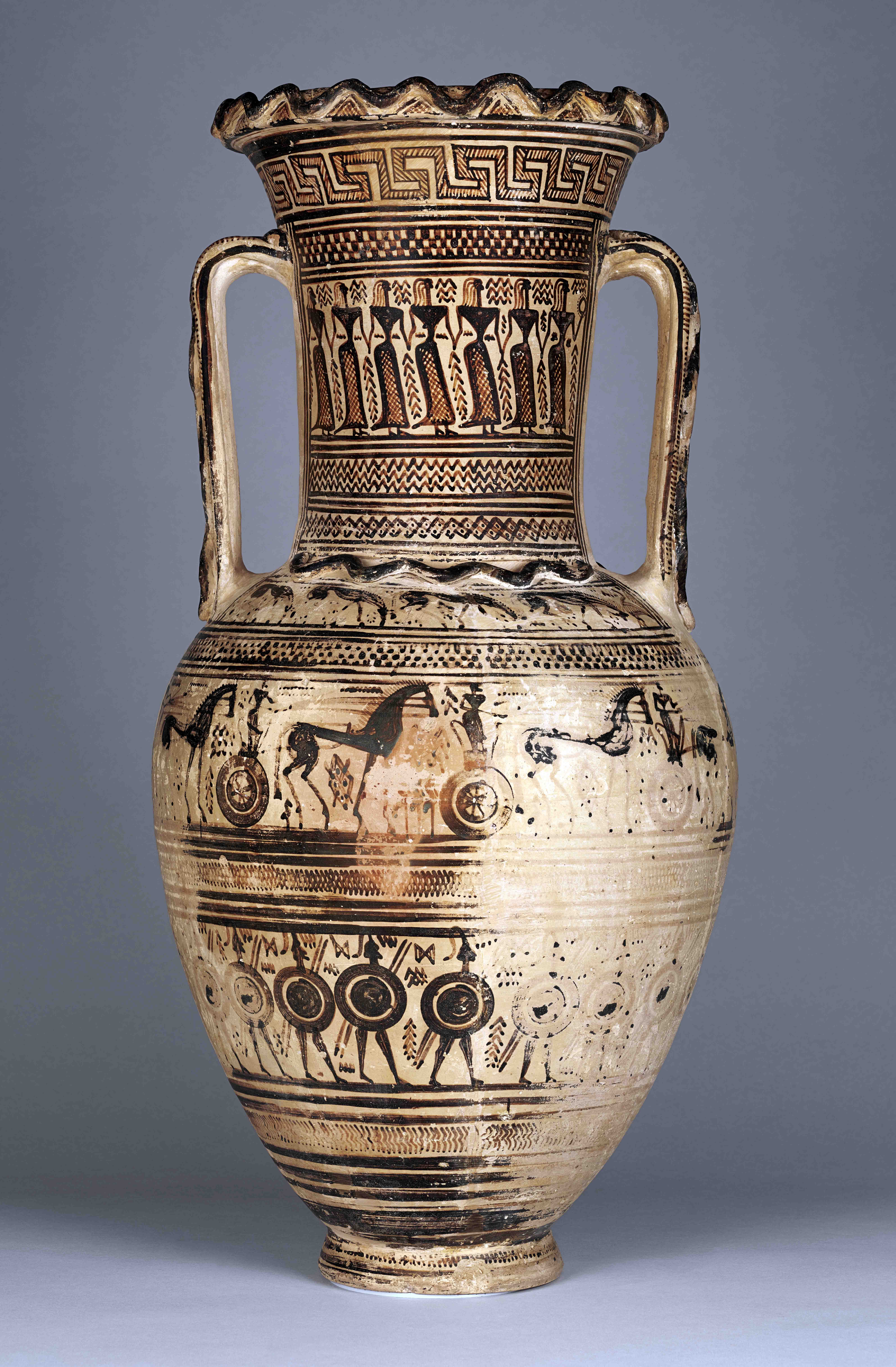
On the neck of this vase, dancing women follow a woman holding a wreath, while processions of men in chariots and armed soldiers decorate the body below. Funerary Amphora with Scenes of Mourning, 720–700 B.C., Greek, made in Athens. Terracotta, 27 5/8 x 12 in. The J. Paul Getty Museum, 2016.35. Purchased in part with funds provided by the Villa Council. Digital image courtesy of the Getty’s Open Content Program
Not unlike today, planning a funeral in ancient Greece could be a lengthy and complicated process. The relatives of the deceased arranged elaborate funerary rites to lament, honor, and celebrate the dead, along with setting up a commemorative monument to mark the burial plot.
Painted scenes on two large Athenian vases now on display in the newly reinstalled Getty Villa—including an exceptional new acquisition on view for the first time—highlight the main events of a traditional Greek funeral.
Standard representations of funeral practices on pottery in the Greek Geometric period (about 900–700 B.C.) depict events that likely occurred in real life. They illustrate the practical steps a family would take to properly care for the dead and guarantee the transition between death and the afterlife.
Step One: The Prothesis
The first step was the prothesis, or laying out of the body, usually within the home. In Greece, women played a central role in this rite. They washed and dressed the body, anointed it with oil, and arranged it on a bier or bed. The bier was usually covered with pillows and blankets, evoking an association between sleep and death. During this vigil, relatives and friends came to mourn the deceased and pay their respects.
In the main scene on the body of one vase, the corpse rests on a high bier, while men and women stand on either side, raising their hands in gestures of lamentation. One individual reaches out to touch the foot of the bier, while another kneels at the head. Two additional figures kneel below. Grieving women decorate the neck of the vase, emphasizing the sorrowful nature of the event.
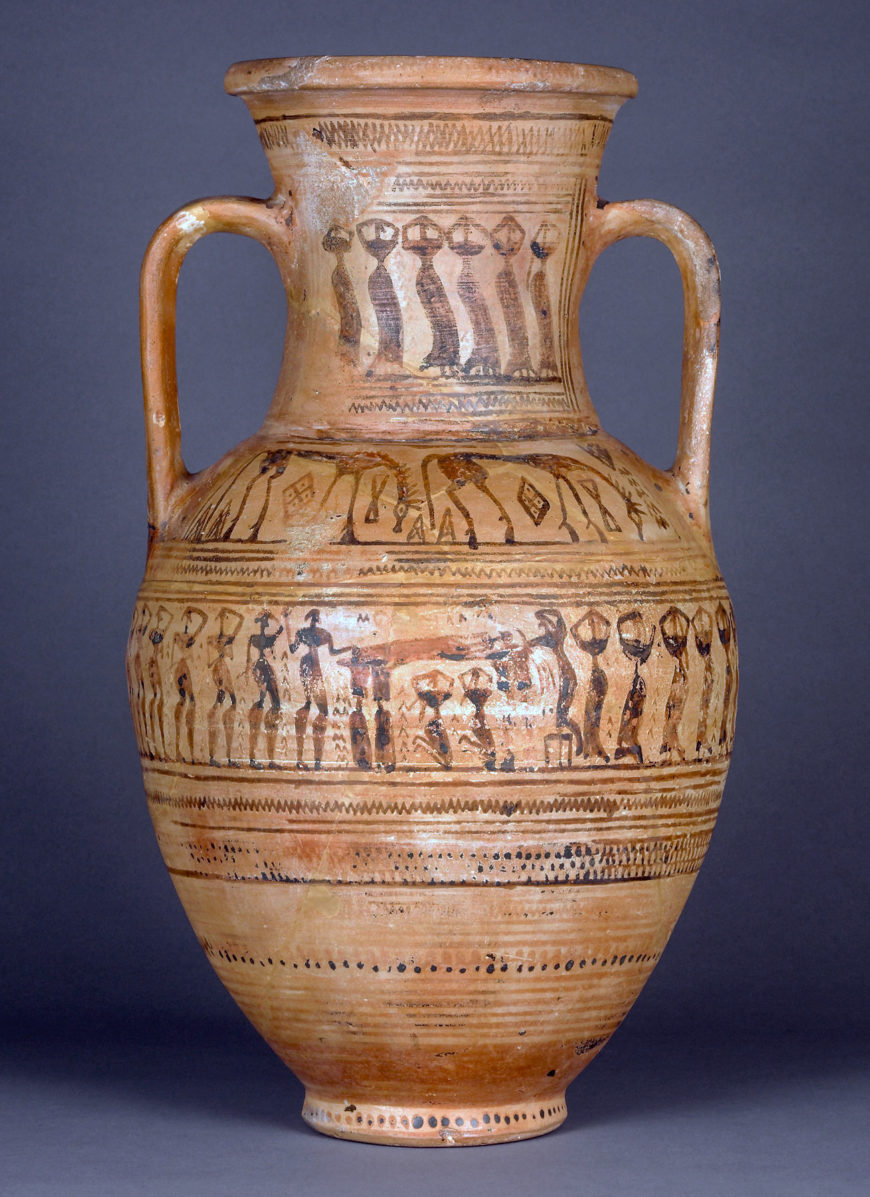
In the main scene on this vessel, the body of the deceased lies on a high bed with male and female mourners on either side. Another row of grieving woman decorates the neck of the vase above. Funerary Vessel, 710–700 B.C., Greek, made in Athens. Lent from the Rabin Collection, VL.2010.22
Step Two: The Ekphora
Following the prothesis, the mourners carried the deceased to the cemetery in a funeral procession, the ekphora, which usually took place just before dawn. They transported the body by chariot, cart, or on foot—the equivalent of our modern-day automobile cavalcade. Musicians and performers often accompanied this public display, as we see on the neck of the Getty’s newly acquired vase.
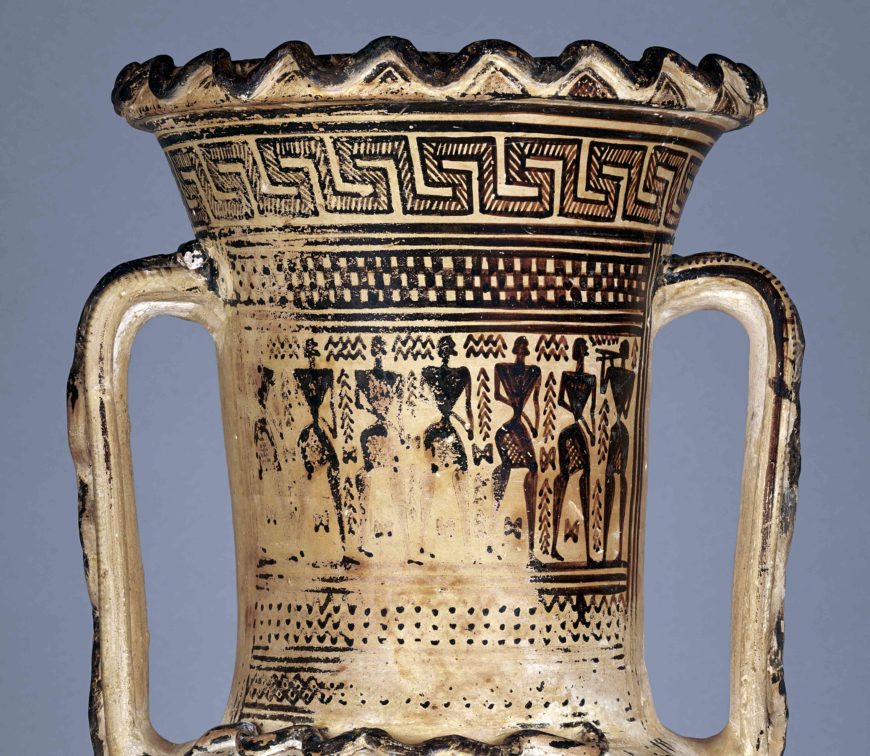
Detail of Funerary Amphora with Scenes of Mourning showing men following an aulos player in the funerary procession.
A group of men follow the music of an aulos (flute) player, while on the opposite side a woman holding a wreath leads a row of women dancing hand in hand. Snakes, traditionally associated with death, slither across the handles, shoulder, and rim of the vase. The scenes below of men in horse-drawn chariots and armed soldiers may represent ceremonial processions or funerary games held in honor of the deceased.
Step Three: Internment
The vases themselves marked the final step, the interment of the corpse. Both vessels originally served as grave markers in a cemetery. Their large size and decorative themes reveal their function as funerary monuments. But not everyone could afford such finely decorated vases. Wealthy families placed these more elaborate vessels at grave sites as a sign of their elite status in the community.
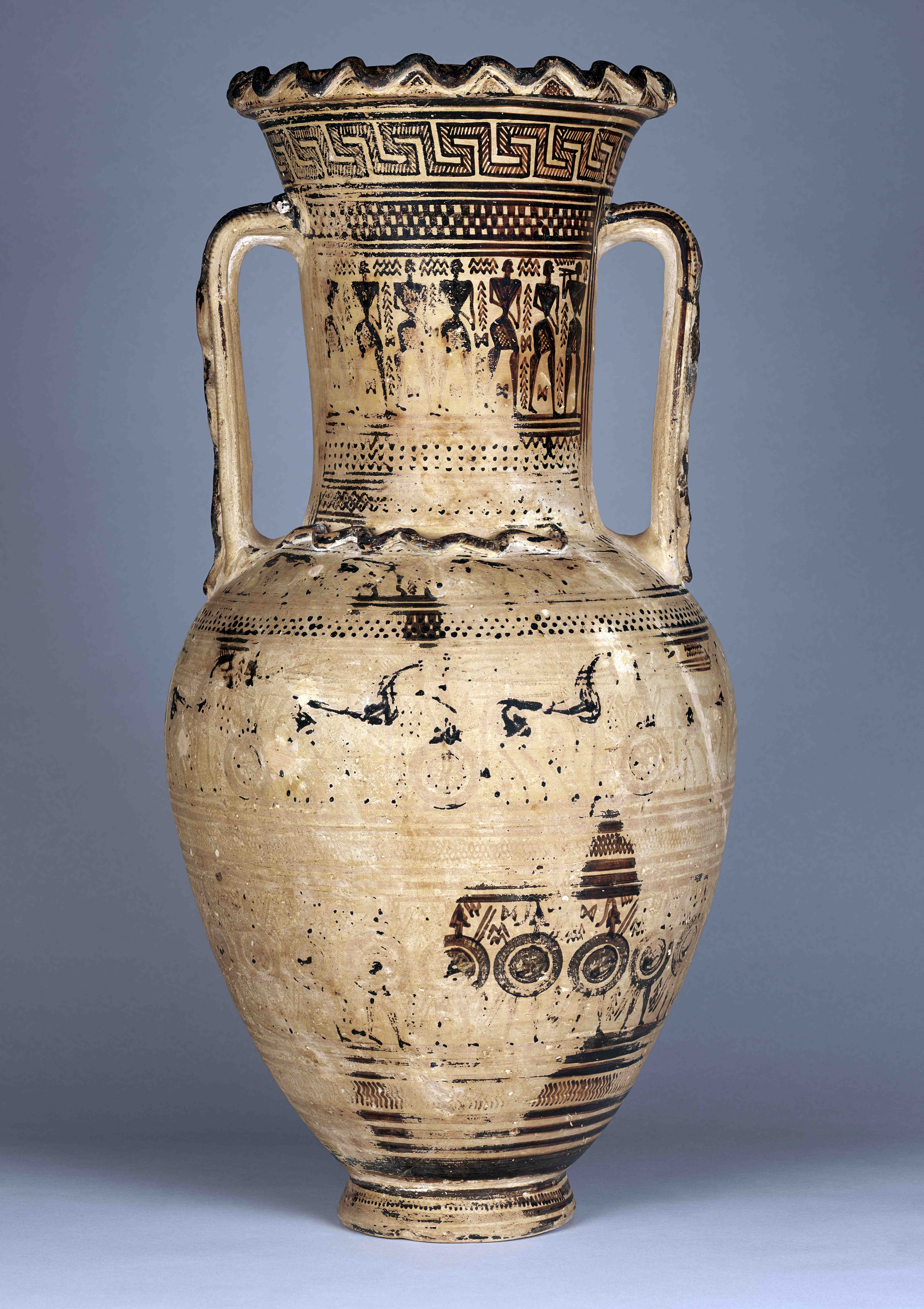
Funerary Amphora with Scenes of Mourning, 720–700 B.C., Greek, made in Athens. Terracotta, 27 5/8 x 12 in. The J. Paul Getty Museum, 2016.35. Purchased in part with funds provided by the Villa Council. Digital image courtesy of the Getty’s Open Content Program
The most common decorative motifs—chariots, warriors, and horses—likely symbolized the heroic world of aristocratic warriors and their equipment. Battles and ceremonies for the dead are recurring themes in Homer’s epic poems, the Iliad and the Odyssey, which were written down for the first time in the Geometric period.
Step Four: Commemoration
The ancient Greeks believed that the moment the psyche (soul) departs the body is only the beginning of death. Each event detailed on the vases on display at the Getty Villa marked a necessary stage in the passage to the afterlife. To join the dead required the execution of all these steps; after all, Hades only accepts to the Underworld those whose deaths are complete.
The funerary scenes that decorate these monuments therefore commemorate the entire process, not just the individual who died. Although the decoration anticipates later interest in human figures, representations of the deceased in Geometric art rarely show personalized features other than gender.
An Alternative Way to Memorialize
This attitude toward remembering the dead contrasts considerably with Archaic (700–480 B.C.) and Classical Greek (480–323 B.C.) stone grave monuments, which not only picture the deceased with individualized traits but often identify them by name.
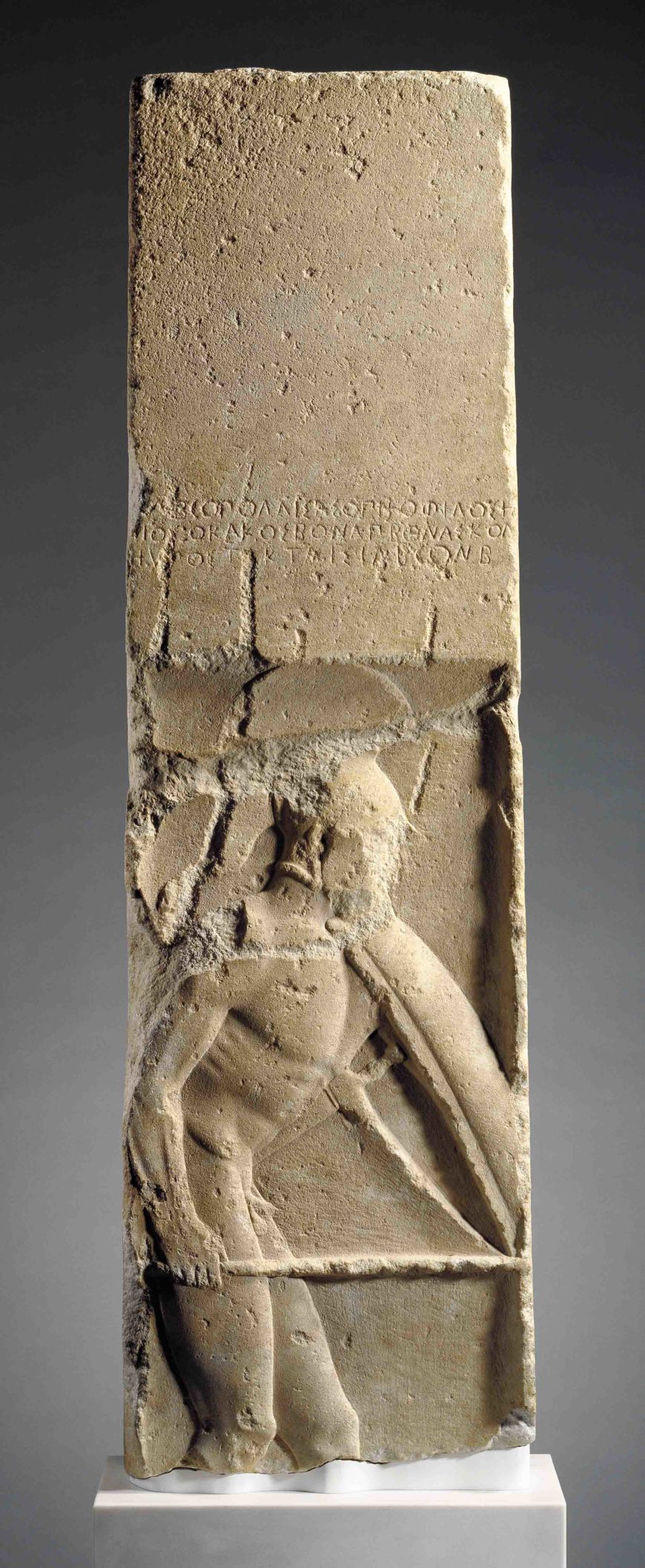
Gravestone of Pollis, about 480 B.C., Greek, made in Megara. Parian marble, 60 ¼ in. high. The J. Paul Getty Museum, 90.AA.129. Digital image courtesy of the Getty’s Open Content Program
In one fifth-century B.C. stele also on display at the Villa, a helmeted warrior advances into battle with his shield raised and spear ready. The Greek inscription above identifies him as Pollis, son of Asopichos, who perished at the hands of the “tattooers.” The tattooed enemies referred to in the epitaph were the Thracians, a tribe from the north that fought on the side of the Persian invaders in the war of 480–479 B.C. Although the Greeks were victorious, Pollis lost his life. The grave monument commemorates not only Pollis but also his death as a fallen warrior.
All these monuments illustrate how the Greeks commemorated the dead. They confirmed that the deceased had successfully transitioned to the underworld and preserved their memory for future generations. The link between the realms of the living and dead were entwined even in life. The two vases were made in the main cemetery in ancient Athens, the Kerameikos—named from the Greek word for pottery—which lay just outside the city gate. [1] When approaching Athens, therefore, a visitor had to first walk through a veritable city of the dead.
Essay first appeared in the iris.
Notes:
[1] In this case, the original text should read that the vases were not made in the cemetery, but were made in the Potter’s Quarter of the area called the Kerameikos.
Cite this page as: Dr. Alexis Belis, “Commemorating the Dead in Greek Geometric Art,” in Smarthistory, May 23, 2020, accessed May 29, 2024, https://smarthistory.org/commemorating-the-dead-in-greek-geometric-art/.











